Jason Schneider
the Camera Collector
Leica Motor Drives: the good, the bad, and the cantankerous
The first one was a mechanical masterpiece, the last one’s OK, but…
By Jason Schneider
The very first Leica motor drive was listed in the catalog as MOOLY, and since its whimsical 5-letter Leitz code name is pronounceable, that’s what folks have been calling it ever since. Announced in 1938 as an accessory motor drive for the Leica IIIa/IIIb it set the industry standard, and reigned supreme for nearly 20 years before electric motors took over as the primary drivers for camera motors in the film era.
The much-admired MOOLY is encased in a smartly styled housing matching the Leica’s curvilinear contours, and it replaces the baseplate of all screw-mount Leicas above serial number 159000. The housing contains a wind-up spring-driven clockwork mechanism that connects to the take-up spool, advances the film, and fires the shutter. Previous models required a new Leica take-up spool with an engagement slot, and Leicas with serial numbers below 111450 also needed a larger-diameter baseplate-securing pin.
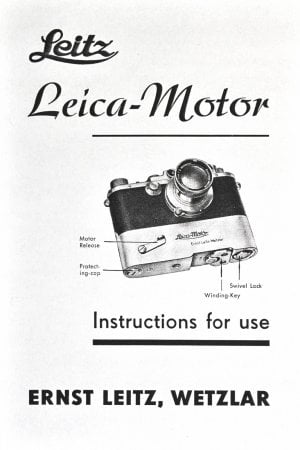
Cover of English language manual for the MOOLY, c. 1939. Note winding key on bottom of unit, and lever type release on front.
You fired your MOOLY-equipped Leica by pressing a lever on the front of the unit, and the shutter was released via an external vertical linkage on the back of the camera that terminates in right-angled angled tab positioned over the shutter release button. Once you fully wind the hinged key on the base of the chrome-finished unit you have enough spring power for 12 exposures, assuming the spring is still up to snuff. The earliest models gave you a choice of 1 or 2 frames per sec, but this feature was dropped by late 1938, and 2 fps was the sole framing rate.
In 1940, Leica introduced the MOOLY-C for the Leica IIIc, which had a body that was 2.8mm longer than previous Leicas. The MOOLY-C uses an internal linkage rather than an external arm to fire the shutter—a much cleaner arrangement. Most MOOLY-Cs are finished in chrome as well, but they can also be found in gray or black paint. Wartime gray is said to be the rarest color, and those with “K” markings, indicating they were made for the legendary Leica IIIc K-model Leicas with all-ball-bearing shutters, are the rarest and priciest of all.
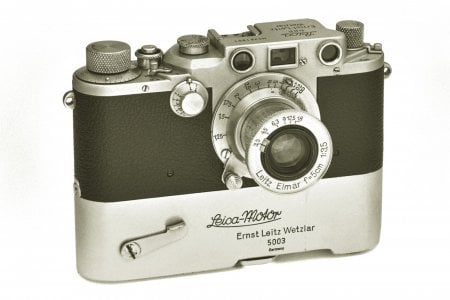
A wartime Leica IIIc fitted with a MOOLY-C Leica-Motor, a rare collector's prize that fetches a princely price.
Finding a MOOLY in perfect operating condition is possible if you have deep enough pockets. You can probably acquire an original chrome one for $800-$1,200, but a chrome MOOLY-C can easily run $2,000-$3,000 and pristine black-finished MOOLY-C to fit your rare military IIIc are currently running about $4,000-$5,000. Can you snag one for less? Hope springs internal-
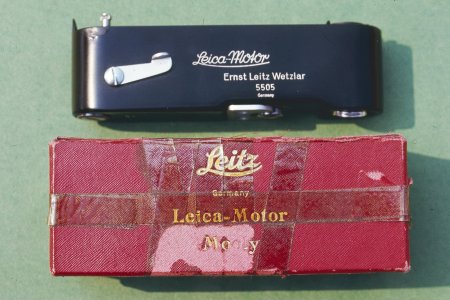
Super rare black finished MOOLY-C Leica-Motor and its battered original box. It's a beauty all right, but hellaciously expensive.
The Leitz MOOLY qualifies as the first detachable motor drive designed for a 35mm rangefinder system, but it was by no means the first spring motor drive camera. That honor goes to the “Le Pascal” made in France by Japy et Cie in 1898, a “pre-wound” spring-driven roll film camera. The first spring motor 35mm camera was probably the Debrie “Sept,” launched in 1922, a boxy creation with the motor housing mounted on the side. Ungainly but functional, it could be used as a still camera, a sequence camera, a (short run) movie camera, and, with the addition of a light source, as a still projector, a cine projector, or an enlarger! The Americans got into the act too, although not in 35mm. The Semi-Automatic Ansco of 1924 looked like a typical folding roll film camera of the era but it had a key to wind the motor instead of a film wind knob and advanced the film one frame at a time when you pressed and released a small lever protruding from the body. In 1925 Ansco announced the improved Automatic 1A, which coupled the film wind with the shutter release, but you still had to press the shutter release again and again to advance each successive frame.
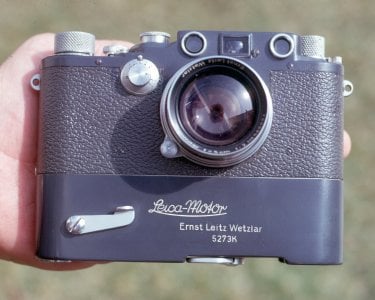
Ultra-rare gray finished MOOLY-C Leica-Motor on a matching Leica IIIcK with ball bearing shutter. Many of these saw military use during WWII.
The German camera that inspired the MOOLY? Maybe.
If any camera can be credited with inspiring the MOOLY, it’s probably the Robot I of 1934, a scale focusing, interchangeable lens 35 that was the brainchild of Heinz Kilfitt (later of lens fame), who sold the idea to Hans Berning. The first in a long series of 35mm spring-motor-drive sequence cameras made by Otto Berning & Co. of Dusseldorf, Germany, the Robot I is based on a unique metal rotary shutter design, essentially a behind-the-lens guillotine type with a separate capping mechanism in front. The film-advance spring is wound with a hefty textured knob atop the camera and film advances to the next frame automatically as soon the shutter fires. Like all scale-focusing Robots, the model I features a 24x24mm format, shutter speeds to 1/500 and was ruggedly constructed of first-rate materials. Screw-mount interchangeable lenses by Zeiss, Schneider, and Meyer were generally excellent. Robot cameras were used by the Luftwaffe during WWII and early in the American space program. The Robot I is now premier collector’s item valued at $500 and up for a pristine working example with Tessar or Xenar lens.
The Leica 250 Reporter Motors
The Leica 250, aka Leica Reporter is a rare, collectible 250-exposure version of the classic rangefinder Leica II, III, or IIIa featuring enlarged rounded ends integrated into the body to accommodate magazines containing 33 feet of 35mm film. The 250-exposure load filled the KBOOF feed cassette on the left and the exposed film was transported into a second KBOOF take-up cassette on the right. There’s a beautiful 250-exposure film counter inset with a classic film-wind knob atop the right-hand end, and a conventional rewind knob on the left. The very first Leica Reporter of 1933, was based on the Leica II. It’s dubbed the DD, and only 2 were ever made. The most common Leica Reporters are the Leica FF based on the Leica III with a top shutter speed of 1/500 sec and the more famous Leica GG based on the Leica IIIa with a top shutter speed of 1/1000. Both were available in black or chrome finish, and when the last Leica Reporter rolled off the line in Wetzlar in 1953, total production came to approximately 950 cameras, making this Oskar Barnack designed classic one of the rarest of all Leicas. Current used prices are astronomical, most falling within the $15K to $30K range.
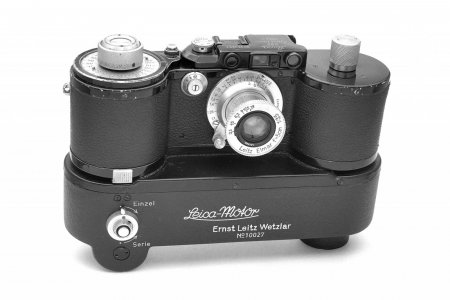
Leica Reporter No.353653 with Leica-Motor No. 10027: Made in the early '40s, it was sent to the U.S, Air Force in '45 "for evaluation."
Between 1939 and 1945 Leitz Wetzlar manufactured electric Leica-Motors for the 250-exposure Leica Reporter, most likely for wartime military applications. The earliest examples have a MOOLY-style external shutter release arm and a drive post fitting the fully slotted coupling shaft on the camera. Later 250 motors are internally linked to the camera by means of an angled hook, and Leica Reporters modified to take the electric motor are fitted with a coupling shaft that accepts the motor’s drive post. The records indicate that Leica Reporter No. 353653 with Leica Motor No. 10027 was delivered to an officer of the U.S. 9th Air Force on October 9, 1945, at Wright Field in Dayton, Ohio for technical evaluation. Listed as MOOEV in the Leitz 5-letter product code, only about 100 were ever made. This one was probably delivered to the German miliary sometime between 1941 and 1944 and is one of a very few to have survived the war. Powered by a 24-volt power supply it had a motor release and a selector switch for single or series exposures, but sadly its maximum framing rate is unavailable.
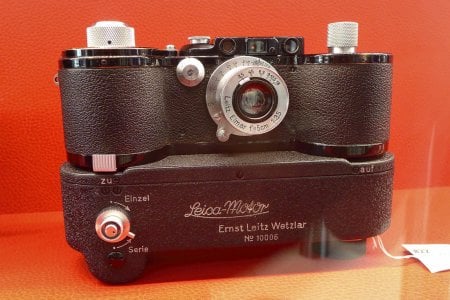
Leica 250 Reporter with rare electric Leica-Motor: Note settings for single frame (Einzel) and burst (Serie) film advance.
Norman Goldberg’s “New York Motor Drive” for the Leica M2 & M4
Norman Goldberg, inventor, camera guru, and longtime Technical Director of Popular Photography magazine, had been working on a motor drive for Leica M cameras even before the M2 was released in 1957. When he examined the then-new M2 he redoubled his efforts and the result, after a lengthy period of testing and development, was the Camcraft N-5 motor, unveiled in 1961, that fit the Leica M2, M1 and (old style, limited edition) MP. Functionally the motor was a great success, and by 1964, 30 units had been sold, battery packs and a charger were offered, and a remote-control unit was available.
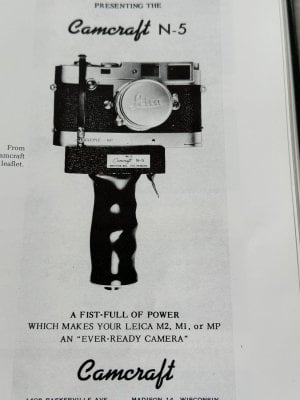
Flyer for Norman Goldberg's Camcraft N-5 Motor. A more compact, streamlined version with internal linkage became the Leitz New York Motor.
Goldberg then made major modifications to the design, and dubbed the improved version the Remodrive, which was sold to and manufactured by Technical Photomation Instruments of Los Angeles and shown at the IPEX show in Spring, 1965. Leitz bought the rights to this improved design, and over the years, manufactured a thousand or more units of the “New York Motor” which were sold with modified “sub-models” of the M2 and M4, the M2M and, later, the M4M. Early Leitz New York motors lack micro switch contacts and have a remote-control receptacle that accepts a standard two prong plug. Later models have micro switch contacts, and separate sockets for external DC power and remote control. The New York Motor was last catalogued in 1972 and is now only available used. Current online auction prices: Leitz, New York Motor for Leica M1, M2, old MP, $5.5K-$6K; Leica MDa with Leitz, New York Motor, $4K; Leica M2M body, $7K. A chrome Leica M4M body recently sold at a European auction for 10,000 Euros ($10,979.50)!
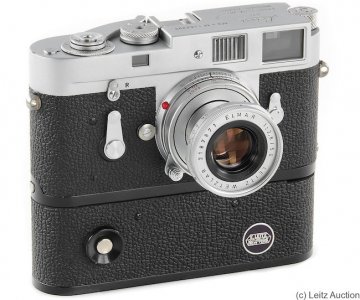
Leica M2-M (modified M2) with Leitz New York Motor, but without bottom mounted battery pack, courtesy Leitz Auction.
In designing his simple and innovative N-5 motor drive, Goldberg wisely opted to use the preexisting Leicavit MP to mate the electric motor with the camera. The motor was contained in a molded plastic grip and was powered via a cable running to a shoulder-slung battery pack. A traditional wet-cell battery was used, and a framing rate up to 3.6 fps second was possible at shutter speeds of 1⁄50 sec and faster. Like the MOOLY, the shutter release was depressed by an external L-shaped strip of metal, this time running vertically up the front of the camera, a simple solution that made it possible to replace a camera body quickly and easily once the film was exposed. There was also a unique and massive “Model 14000” with a switch on the bottom to select 3 fps at speeds of 1/50 sec and faster. and 1 fps at slower speeds.
What made Goldberg’s N-5 motor drive a success was it was its simplicity, robustness, and straightforward ingenuity. Leitz abandoned its own efforts and bought the rights to Goldberg’s redesigned motor drive because they could see it was better than what they had come up with. What made it possible was a good small electric motor, and reliable high-quality microswitches, which, that time, were available only in the U.S.A., a spin-off of the U.S. space program.
The Leica Winder M and Leica Motor M
Prior to 1976, regular Leica M shooters only had two rapid fire choices: the Leicavit trigger winder of 1960-1966 that only worked on the Leica M1, M2, MD, and the original MP of the ‘50s, and the Goldberg-designed “New York Motor Drive,” both now rare and very expensive.
In 1976 Leitz brought forth the Leica M4-2 and the Leica M4-2 winder (model 14214), which, fortunately or unfortunately did not work on earlier or later Leica Ms. For more effective marketing, they should have called it a motor, even though early examples prior to serial number 10350 have a top framing rate of only 2 fps without continuous operation. Later M4-2 Winders with serial numbers of 10350 and above allow continuous operation at up to 3 fps, are powered by 4 AA batteries, and will fit the M6. However, many users have stated that both deliver too much torque for the M mechanism, are unreliable, and should be avoided despite being readily available used at prices around $50-$75 on the top online auction sites.
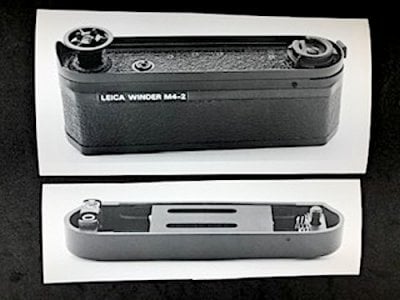
Leica Winder M4-2 with 4 AA battery pack removed: it was a start, but not a reliable one, and you can now snag one for a pittance.
There was a rare M4-P winder, marked as such, that was introduced just before the Leica M6, and it was soon relabeled, possibly with minor changes, as the Winder M. Is it worth the silly prices being asked? Probably not, but Leica collectors have a penchant for bidding up the prices of anything with distinctive markings made in small quantities.
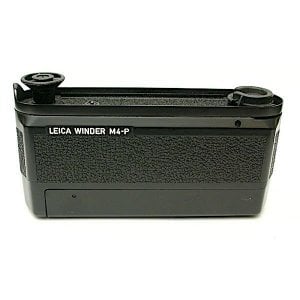
Rare Leica Winder M4-P: With minor changes it evolved into the Leica Winder M (Model 14404), still no paragon of smoothness or reliability.
In 1987, Leica introduced the Leica Winder M (Model 14403), essentially the same as the M4-2 Winder, but compatible with the Leica M4-2, M4-P, M6, M7, and the new MP. It has less torque than the previous model (but is still not recommended for the M3), takes 4 AA batteries, and provides a framing rate up to 3 fps, but smooth operation is not its forte, its reliability is so-so, and repairs are hard to come by. If you’re an adventurous type and want to give it a go, you can snag one of these beauties used for $50-$125 at all the usual places.
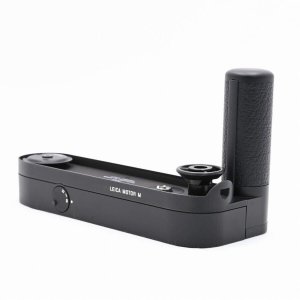
Leica Motor-M of 2000 is the best if the bunch and a reasonable choice for users: It fits the Leica M6, M7 and new MP, can work with others.
In 2000, Leica replaced the Winder M with the more appropriately named Leica Motor M (Model 14408), retaining its 3-fps top framing rate, adding an integrated grip for easier handling, and for the first time providing a camera/motor unit that won’t fall over on its face when you set it on a tabletop! It also provides single frame advance plus continuous speed settings of 1.5 and 3 fps, smoother, more quiet operation than previous Leica winder/motors, and has a timed safety switch that turns the unit off after 2 sec of non-use. On the downside, its plastic grip doesn’t look very robust (though no failures have been reported) and it takes two Type 123A 3v lithium batteries (in the grip) rather than cheaper, more readily available AA cells. If you must equip your elegantly minimalist Leica with a motor drive, this is by far the best choice, and clean working examples are readily available at the top online auction sites at prices ranging from $350-$500.
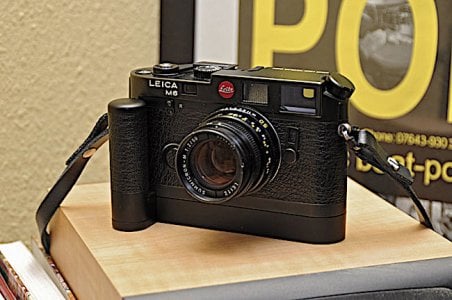
Leica M6 with Leica Motor M (type 14408): If you must have a classic Leica M with a 3 fps motor drive, this combo is as good as any.
It can be argued that none of the battery powered Leica motors and motor winders mentioned above are equal to Leica M cameras in terms if their overall quality, finesse, and reliability. If you want a faster winding analog Leica M, there is one elegant solution: the acclaimed Abrahamsson Rapidwinder trigger. Sadly, it’s out of production, but you can snag a clean used one that fits your Leica M6 for about $650-$700. An original vintage model for the M2, M1, and old MP will set you back about $2K or even more!
Today, both camera bodies and motors for the M2M, M4MOT and M4M are sought after and expensive, yet real world they were slow motors compared the best contemporary equivalents from Nikon or Canon and not that popular, practical or hockey puck reliable as the Nikon F and F2 motors. Of all things, it’s the great rise in the cost of film and processing, and the dominance of art photography among of today’s film shooters that killed user’s enthusiasm for racing film thru their film gates. Such a stark reality was truly unimaginable in film’s long pre- digital heyday while film and processing were still relatively inexpensive. It’s been said before and we’ll say it again: Damn, those were the days!
The first one was a mechanical masterpiece, the last one’s OK, but…
By Jason Schneider
The very first Leica motor drive was listed in the catalog as MOOLY, and since its whimsical 5-letter Leitz code name is pronounceable, that’s what folks have been calling it ever since. Announced in 1938 as an accessory motor drive for the Leica IIIa/IIIb it set the industry standard, and reigned supreme for nearly 20 years before electric motors took over as the primary drivers for camera motors in the film era.
The much-admired MOOLY is encased in a smartly styled housing matching the Leica’s curvilinear contours, and it replaces the baseplate of all screw-mount Leicas above serial number 159000. The housing contains a wind-up spring-driven clockwork mechanism that connects to the take-up spool, advances the film, and fires the shutter. Previous models required a new Leica take-up spool with an engagement slot, and Leicas with serial numbers below 111450 also needed a larger-diameter baseplate-securing pin.

Cover of English language manual for the MOOLY, c. 1939. Note winding key on bottom of unit, and lever type release on front.
You fired your MOOLY-equipped Leica by pressing a lever on the front of the unit, and the shutter was released via an external vertical linkage on the back of the camera that terminates in right-angled angled tab positioned over the shutter release button. Once you fully wind the hinged key on the base of the chrome-finished unit you have enough spring power for 12 exposures, assuming the spring is still up to snuff. The earliest models gave you a choice of 1 or 2 frames per sec, but this feature was dropped by late 1938, and 2 fps was the sole framing rate.
In 1940, Leica introduced the MOOLY-C for the Leica IIIc, which had a body that was 2.8mm longer than previous Leicas. The MOOLY-C uses an internal linkage rather than an external arm to fire the shutter—a much cleaner arrangement. Most MOOLY-Cs are finished in chrome as well, but they can also be found in gray or black paint. Wartime gray is said to be the rarest color, and those with “K” markings, indicating they were made for the legendary Leica IIIc K-model Leicas with all-ball-bearing shutters, are the rarest and priciest of all.

A wartime Leica IIIc fitted with a MOOLY-C Leica-Motor, a rare collector's prize that fetches a princely price.
Finding a MOOLY in perfect operating condition is possible if you have deep enough pockets. You can probably acquire an original chrome one for $800-$1,200, but a chrome MOOLY-C can easily run $2,000-$3,000 and pristine black-finished MOOLY-C to fit your rare military IIIc are currently running about $4,000-$5,000. Can you snag one for less? Hope springs internal-

Super rare black finished MOOLY-C Leica-Motor and its battered original box. It's a beauty all right, but hellaciously expensive.
The Leitz MOOLY qualifies as the first detachable motor drive designed for a 35mm rangefinder system, but it was by no means the first spring motor drive camera. That honor goes to the “Le Pascal” made in France by Japy et Cie in 1898, a “pre-wound” spring-driven roll film camera. The first spring motor 35mm camera was probably the Debrie “Sept,” launched in 1922, a boxy creation with the motor housing mounted on the side. Ungainly but functional, it could be used as a still camera, a sequence camera, a (short run) movie camera, and, with the addition of a light source, as a still projector, a cine projector, or an enlarger! The Americans got into the act too, although not in 35mm. The Semi-Automatic Ansco of 1924 looked like a typical folding roll film camera of the era but it had a key to wind the motor instead of a film wind knob and advanced the film one frame at a time when you pressed and released a small lever protruding from the body. In 1925 Ansco announced the improved Automatic 1A, which coupled the film wind with the shutter release, but you still had to press the shutter release again and again to advance each successive frame.

Ultra-rare gray finished MOOLY-C Leica-Motor on a matching Leica IIIcK with ball bearing shutter. Many of these saw military use during WWII.
The German camera that inspired the MOOLY? Maybe.
If any camera can be credited with inspiring the MOOLY, it’s probably the Robot I of 1934, a scale focusing, interchangeable lens 35 that was the brainchild of Heinz Kilfitt (later of lens fame), who sold the idea to Hans Berning. The first in a long series of 35mm spring-motor-drive sequence cameras made by Otto Berning & Co. of Dusseldorf, Germany, the Robot I is based on a unique metal rotary shutter design, essentially a behind-the-lens guillotine type with a separate capping mechanism in front. The film-advance spring is wound with a hefty textured knob atop the camera and film advances to the next frame automatically as soon the shutter fires. Like all scale-focusing Robots, the model I features a 24x24mm format, shutter speeds to 1/500 and was ruggedly constructed of first-rate materials. Screw-mount interchangeable lenses by Zeiss, Schneider, and Meyer were generally excellent. Robot cameras were used by the Luftwaffe during WWII and early in the American space program. The Robot I is now premier collector’s item valued at $500 and up for a pristine working example with Tessar or Xenar lens.
The Leica 250 Reporter Motors
The Leica 250, aka Leica Reporter is a rare, collectible 250-exposure version of the classic rangefinder Leica II, III, or IIIa featuring enlarged rounded ends integrated into the body to accommodate magazines containing 33 feet of 35mm film. The 250-exposure load filled the KBOOF feed cassette on the left and the exposed film was transported into a second KBOOF take-up cassette on the right. There’s a beautiful 250-exposure film counter inset with a classic film-wind knob atop the right-hand end, and a conventional rewind knob on the left. The very first Leica Reporter of 1933, was based on the Leica II. It’s dubbed the DD, and only 2 were ever made. The most common Leica Reporters are the Leica FF based on the Leica III with a top shutter speed of 1/500 sec and the more famous Leica GG based on the Leica IIIa with a top shutter speed of 1/1000. Both were available in black or chrome finish, and when the last Leica Reporter rolled off the line in Wetzlar in 1953, total production came to approximately 950 cameras, making this Oskar Barnack designed classic one of the rarest of all Leicas. Current used prices are astronomical, most falling within the $15K to $30K range.

Leica Reporter No.353653 with Leica-Motor No. 10027: Made in the early '40s, it was sent to the U.S, Air Force in '45 "for evaluation."
Between 1939 and 1945 Leitz Wetzlar manufactured electric Leica-Motors for the 250-exposure Leica Reporter, most likely for wartime military applications. The earliest examples have a MOOLY-style external shutter release arm and a drive post fitting the fully slotted coupling shaft on the camera. Later 250 motors are internally linked to the camera by means of an angled hook, and Leica Reporters modified to take the electric motor are fitted with a coupling shaft that accepts the motor’s drive post. The records indicate that Leica Reporter No. 353653 with Leica Motor No. 10027 was delivered to an officer of the U.S. 9th Air Force on October 9, 1945, at Wright Field in Dayton, Ohio for technical evaluation. Listed as MOOEV in the Leitz 5-letter product code, only about 100 were ever made. This one was probably delivered to the German miliary sometime between 1941 and 1944 and is one of a very few to have survived the war. Powered by a 24-volt power supply it had a motor release and a selector switch for single or series exposures, but sadly its maximum framing rate is unavailable.

Leica 250 Reporter with rare electric Leica-Motor: Note settings for single frame (Einzel) and burst (Serie) film advance.
Norman Goldberg’s “New York Motor Drive” for the Leica M2 & M4
Norman Goldberg, inventor, camera guru, and longtime Technical Director of Popular Photography magazine, had been working on a motor drive for Leica M cameras even before the M2 was released in 1957. When he examined the then-new M2 he redoubled his efforts and the result, after a lengthy period of testing and development, was the Camcraft N-5 motor, unveiled in 1961, that fit the Leica M2, M1 and (old style, limited edition) MP. Functionally the motor was a great success, and by 1964, 30 units had been sold, battery packs and a charger were offered, and a remote-control unit was available.

Flyer for Norman Goldberg's Camcraft N-5 Motor. A more compact, streamlined version with internal linkage became the Leitz New York Motor.
Goldberg then made major modifications to the design, and dubbed the improved version the Remodrive, which was sold to and manufactured by Technical Photomation Instruments of Los Angeles and shown at the IPEX show in Spring, 1965. Leitz bought the rights to this improved design, and over the years, manufactured a thousand or more units of the “New York Motor” which were sold with modified “sub-models” of the M2 and M4, the M2M and, later, the M4M. Early Leitz New York motors lack micro switch contacts and have a remote-control receptacle that accepts a standard two prong plug. Later models have micro switch contacts, and separate sockets for external DC power and remote control. The New York Motor was last catalogued in 1972 and is now only available used. Current online auction prices: Leitz, New York Motor for Leica M1, M2, old MP, $5.5K-$6K; Leica MDa with Leitz, New York Motor, $4K; Leica M2M body, $7K. A chrome Leica M4M body recently sold at a European auction for 10,000 Euros ($10,979.50)!

Leica M2-M (modified M2) with Leitz New York Motor, but without bottom mounted battery pack, courtesy Leitz Auction.
In designing his simple and innovative N-5 motor drive, Goldberg wisely opted to use the preexisting Leicavit MP to mate the electric motor with the camera. The motor was contained in a molded plastic grip and was powered via a cable running to a shoulder-slung battery pack. A traditional wet-cell battery was used, and a framing rate up to 3.6 fps second was possible at shutter speeds of 1⁄50 sec and faster. Like the MOOLY, the shutter release was depressed by an external L-shaped strip of metal, this time running vertically up the front of the camera, a simple solution that made it possible to replace a camera body quickly and easily once the film was exposed. There was also a unique and massive “Model 14000” with a switch on the bottom to select 3 fps at speeds of 1/50 sec and faster. and 1 fps at slower speeds.
What made Goldberg’s N-5 motor drive a success was it was its simplicity, robustness, and straightforward ingenuity. Leitz abandoned its own efforts and bought the rights to Goldberg’s redesigned motor drive because they could see it was better than what they had come up with. What made it possible was a good small electric motor, and reliable high-quality microswitches, which, that time, were available only in the U.S.A., a spin-off of the U.S. space program.
The Leica Winder M and Leica Motor M
Prior to 1976, regular Leica M shooters only had two rapid fire choices: the Leicavit trigger winder of 1960-1966 that only worked on the Leica M1, M2, MD, and the original MP of the ‘50s, and the Goldberg-designed “New York Motor Drive,” both now rare and very expensive.
In 1976 Leitz brought forth the Leica M4-2 and the Leica M4-2 winder (model 14214), which, fortunately or unfortunately did not work on earlier or later Leica Ms. For more effective marketing, they should have called it a motor, even though early examples prior to serial number 10350 have a top framing rate of only 2 fps without continuous operation. Later M4-2 Winders with serial numbers of 10350 and above allow continuous operation at up to 3 fps, are powered by 4 AA batteries, and will fit the M6. However, many users have stated that both deliver too much torque for the M mechanism, are unreliable, and should be avoided despite being readily available used at prices around $50-$75 on the top online auction sites.

Leica Winder M4-2 with 4 AA battery pack removed: it was a start, but not a reliable one, and you can now snag one for a pittance.
There was a rare M4-P winder, marked as such, that was introduced just before the Leica M6, and it was soon relabeled, possibly with minor changes, as the Winder M. Is it worth the silly prices being asked? Probably not, but Leica collectors have a penchant for bidding up the prices of anything with distinctive markings made in small quantities.

Rare Leica Winder M4-P: With minor changes it evolved into the Leica Winder M (Model 14404), still no paragon of smoothness or reliability.
In 1987, Leica introduced the Leica Winder M (Model 14403), essentially the same as the M4-2 Winder, but compatible with the Leica M4-2, M4-P, M6, M7, and the new MP. It has less torque than the previous model (but is still not recommended for the M3), takes 4 AA batteries, and provides a framing rate up to 3 fps, but smooth operation is not its forte, its reliability is so-so, and repairs are hard to come by. If you’re an adventurous type and want to give it a go, you can snag one of these beauties used for $50-$125 at all the usual places.

Leica Motor-M of 2000 is the best if the bunch and a reasonable choice for users: It fits the Leica M6, M7 and new MP, can work with others.
In 2000, Leica replaced the Winder M with the more appropriately named Leica Motor M (Model 14408), retaining its 3-fps top framing rate, adding an integrated grip for easier handling, and for the first time providing a camera/motor unit that won’t fall over on its face when you set it on a tabletop! It also provides single frame advance plus continuous speed settings of 1.5 and 3 fps, smoother, more quiet operation than previous Leica winder/motors, and has a timed safety switch that turns the unit off after 2 sec of non-use. On the downside, its plastic grip doesn’t look very robust (though no failures have been reported) and it takes two Type 123A 3v lithium batteries (in the grip) rather than cheaper, more readily available AA cells. If you must equip your elegantly minimalist Leica with a motor drive, this is by far the best choice, and clean working examples are readily available at the top online auction sites at prices ranging from $350-$500.

Leica M6 with Leica Motor M (type 14408): If you must have a classic Leica M with a 3 fps motor drive, this combo is as good as any.
It can be argued that none of the battery powered Leica motors and motor winders mentioned above are equal to Leica M cameras in terms if their overall quality, finesse, and reliability. If you want a faster winding analog Leica M, there is one elegant solution: the acclaimed Abrahamsson Rapidwinder trigger. Sadly, it’s out of production, but you can snag a clean used one that fits your Leica M6 for about $650-$700. An original vintage model for the M2, M1, and old MP will set you back about $2K or even more!
Today, both camera bodies and motors for the M2M, M4MOT and M4M are sought after and expensive, yet real world they were slow motors compared the best contemporary equivalents from Nikon or Canon and not that popular, practical or hockey puck reliable as the Nikon F and F2 motors. Of all things, it’s the great rise in the cost of film and processing, and the dominance of art photography among of today’s film shooters that killed user’s enthusiasm for racing film thru their film gates. Such a stark reality was truly unimaginable in film’s long pre- digital heyday while film and processing were still relatively inexpensive. It’s been said before and we’ll say it again: Damn, those were the days!
Last edited:
Vince Lupo
Untitled
My $400 black Mooly-C, along with a Luftwaffe IIIc. Long gone.
 FL3 by
FL3 by
Vince Lupo, on Flickr
M2 ELCAN modified to accept the Leica Motor M. I had this one for over 20 years, also now gone.
 m1 by
m1 by
Vince Lupo, on Flickr
 FL3 by
FL3 by Vince Lupo, on Flickr
M2 ELCAN modified to accept the Leica Motor M. I had this one for over 20 years, also now gone.
 m1 by
m1 by Vince Lupo, on Flickr
Jason Schneider
the Camera Collector
You remind me of a 700-page book I plan to write entitled "Things I Foolishly Sold" by Jason Schneider-
Vince Lupo
Untitled
Ah that’s nothing - how about the Fuji TX-1 I sold years ago for $1500? Or the overhauled Contaflex TLR? I think you could devote at least a chapter or two just to me.You remind me of a 700-page book I plan to write entitled "Things I Foolishly Sold" by Jason Schneider-
Dralowid
Michael
If you ever stray into the world of Leicaflex SLR motors spare a thought for the motor used on SLMOT and SL2MOT. This lump is so heavy that it balances a 560 Telyt when handheld.
wlewisiii
Just another hotel clerk
The mechanical winders remind me of nothing so much as the snail drum magazine made for the Luger pistol in WW1. Both remind me of the saying to not teach a pig to sing ... 
I like the auto winder on my Nikon F4 but I can guarantee you that given the cost of film & development these days it stays on SINGLE mode!
I like the auto winder on my Nikon F4 but I can guarantee you that given the cost of film & development these days it stays on SINGLE mode!
wlewisiii
Just another hotel clerk
The only thing less likely in my poor brain would be a motor drive on a Super Ikonta! Beautiful! Thank you for showing that 
Pál_K
Cameras. I has it.
Amazing! These early mechanical motor drives were unknown to me. Perhaps one day I'll see one at a swap meet but, even then, I don't think I've got the moola for a MOOLY.
Thank you once again for another enjoyable article.
Thank you once again for another enjoyable article.
Jason Schneider
the Camera Collector
f.hayek
Well-known
No word on the R motor drives...
Jason Schneider
the Camera Collector
No word on the R motor drives...
As we say in what passes for modern American English, a whole nother subject, which I’ll get to eventually.
raydm6
Yay! Cameras! 🙈🙉🙊┌( ಠ_ಠ)┘ [◉"]
Leica Winder M for rapid-fire pinhole shooting 
 Leica M6 | Winder-M | Finney Pinhole Body Cap f/128 @30mm by rdc154, on Flickr
Leica M6 | Winder-M | Finney Pinhole Body Cap f/128 @30mm by rdc154, on Flickr
Quote
 Leica M6 | Winder-M | Finney Pinhole Body Cap f/128 @30mm by rdc154, on Flickr
Leica M6 | Winder-M | Finney Pinhole Body Cap f/128 @30mm by rdc154, on FlickrQuote
Jason Schneider
the Camera Collector
With ISO 3200 film pushed 1-2 stops that might just work—and no worries about DOF!
Jason Schneider
the Camera Collector
Actua
The mechanical winders remind me of nothing so much as the snail drum magazine made for the Luger pistol in WW1. Both remind me of the saying to not teach a pig to sing ...
I like the auto winder on my Nikon F4 but I can guarantee you that given the cost of film & development these days it stays on SINGLE mode!
Jason Schneider
the Camera Collector
The MOOLY was beautifully made and very effective—not a pig in a poke—but it couldn’t sing.
das
Well-known
I think that Leica should have designed these motors with electrical contacts instead of mechanical linkages. Like every other motor drive introduced by the 1970s. There was no excuse not to do this with the Motor M at the very least.
Jason Schneider
the Camera Collector
Considering that the 560mm f/6.8 Leitz Telyt weighs 5.07 pounds, that motor must be a lump indeed. Shooting handheld with a motorized long tele rig weighing in at over 10 pounds does not sound like bliss to me. On the other hand back in the day I shot football with a 5x7 Graflex fitted with a 36-inch B&L “Big Bertha” tele and, with a waist level finder, I needed a spotter to direct me to the action! At least this ponderous rig was mounted on a huge Majestic tripod that probably weighed nearly as much as the camera. Happy days!If you ever stray into the world of Leicaflex SLR motors spare a thought for the motor used on SLMOT and SL2MOT. This lump is so heavy that it balances a 560 Telyt when handheld.
pgk
Well-known
Many years ago I bought a Leica Winder M4-2. In use it sounded like a nail gun going off and the operating mechanism made the whole camera judder. The kindest description that I can apply to it is 'unrefined' but there are more suitable ones. Today, even at $50 it is still too expensive to use as a paperweight which is roughly what it is fit for. The 14408 was in a different league altogether - evolution.
Dralowid
Michael
Perhaps I exaggerate and to be honest my results with that lens were hardly worthwhile. I didn't find the shoulder stock/butt at all comfortable either. Of course one could use the separate power pack and reduce the weight of the motor when using sensible lenses!Considering that the 560mm f/6.8 Leitz Telyt weighs 5.07 pounds, that motor must be a lump indeed. Shooting handheld with a motorized long tele rig weighing in at over 10 pounds does not sound like bliss to me. On the other hand back in the day I shot football with a 5x7 Graflex fitted with a 36-inch B&L “Big Bertha” tele and, with a waist level finder, I needed a spotter to direct me to the action! At least this ponderous rig was mounted on a huge Majestic tripod that probably weighed nearly as much as the camera. Happy days!
I was trying to emulate Douglas Herr, a longtime SL user who produced some fantastic images with Telyts etc.
Share:
-
This site uses cookies to help personalise content, tailor your experience and to keep you logged in if you register.
By continuing to use this site, you are consenting to our use of cookies.


